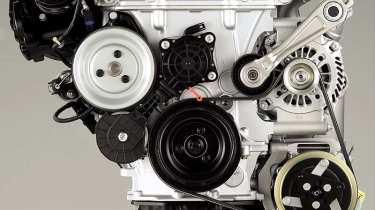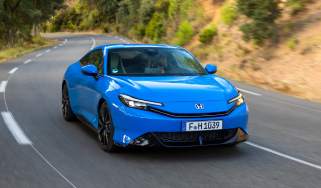MINI's Next Engine
BMW and PSA have announced details of a new generation, joint-venture, high-tech petrol engine range with some intriguing features, to enter production at the end of 2005. These direct-injection (DI), slightly undersquare engines will power the next-generation Mini, the Peugeot 207 and various other transverse-engined cars in the two corporations' present and future ranges.
The 'core' engine is a 1.6-litre in-line four (the next Mini One will get a 1.4-litre version) which is slated to replace existing engines of up to 2 litres when turbocharged. The idea is to save weight and space without losing performance, and the companies claim that the combination of DI and a twin-scroll turbo banishes lag and gives the response feel of a full 2-litre.
The range as envisaged will run from 74bhp to 168bhp, that last one and the 141bhp unit below it being the turbo units. Future developments could take it to the 200bhp mark, although PSA powertrains vice-president Norbert Lartigue says that exhaust-gas temperature will be the limiting factor. And while the power outputs sound promising, BMW and PSA place a higher premium on accessible torque and very flat torque curves: the 141bhp engine delivers 177lb ft between 1400 and 4000rpm.
Both turbo and non-turbo engines have continuously-variable inlet valve timing. The non-turbo unit goes a stage further, with variable exhaust as well, and its intake side is controlled by a system similar to BMW's Valvetronic but more compact. So there's no throttle as such.
BMW took the design and engineering lead, with 60 engineers to PSA's 15, while PSA took charge of components sourcing and productionising and will build the engines at its Douvrin factory. Engines will also be made at BMW's Hams Hall facility near Birmingham.
So, what else is clever about them? They're small and light, having a compact aluminium block and head. The iron cylinder liners are cast in place (no Nikasil coatings here), and there's a 'bearing ladder' in place of separate main bearing caps for extra rigidity. So far so neat, but also so normal among today's engines.
Now, look at the crankshaft. The crank-webs are more slender at the nose of the engine than at the flywheel end. That's because the nearer to the front they are, the less load they have to transmit, so why spin unnecessary weight? The oil pump controls its own flow volume, so it doesn't pump lots of oil when there's no need. The pistons are a slipper design with minimal skirts, like a racing engine's, and have friction-reducing pads on what remains of the skirts.
And check out the water pump. It's driven by a friction wheel pressing on the back of the auxiliary drive belt, and a servomotor ensures the wheel is only in contact when there's a need for water flow. That gives a quick warm-up and saves energy. And because the pump isn't subject to the drive belt's tension, it can have a smaller bearing and a plastic housing.
For us, the turbo engine is the one to watch. Its twin-scroll turbo housing separates the exhaust pulses of cylinders one and four from those of two and three, so there's no interference and maximum effort goes to the turbine blades. It's a key way to banish lag.
Neither company claims to have initiated the collaboration, which is a good example of how car-makers are pooling resources to cut down costs. 'We both needed a new engine range at around the same time, so it made sense,' says Lartigue. However, the first meeting took place in France, and all communication has been in the one shared language - English.
Is BMW besmirching its brand by bonding with a mainstream maker? Well, the use of a cheap Chrysler engine in Minis to date has done no harm. It's a case of needs must, and everyone's happy.



